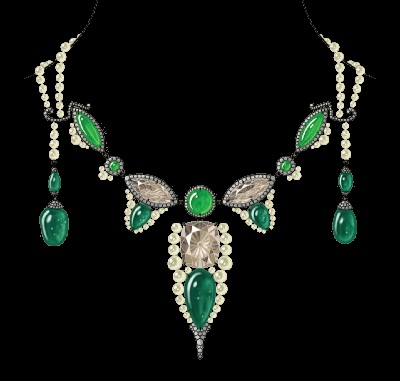Design plagiarism in the jewellery industry

Design plagiarism has been hampering the integrity of the jewellery industry for a long time now. But times are changing and accusations of copying are popping up far more frequently now than they have before, thanks to Social Media. We took to Instagram in conducting a survey, to understand how deep-rooted the issue of plagiarism is and how aware the industry is about the Intellectual Property (IP) law in India. We also got in touch with an IP lawyer who enlightened us about a few misconceptions the industry has regarding the Law. A plagiarised economy will eventually damage the spirit of creativity, even though many designers have chosen the more magnanimous path and have risen above their copyists. In keeping silent, we are only encouraging copyists and the time to call their bluff is now says Vijetha Rangabashyam.
Copying design is not a new problem in the business of fashion; it is deep-rooted, perhaps as old as the process of design itself. Unfortunately, today with an industry like jewellery being inundated with a flurry of new designs every day, and where ideas and concepts are available at the click of a button, copying has become an epidemic. And the issue is not as black and white as we may think it is, especially where it concerns design.
The Indian jewellery market is also multifaceted, where there are couture jewellers who create bespoke pieces, retail stores that sells jewellery to the masses, fashion jewellery designers who are trying to create a niche for themselves and finally, a thriving market for cheap knock-offs and imitation jewellery that seem to be making its way into some of India’s busiest streets. When successful designs that have set a trend are blatantly copied at every level, the brand’s equity gets irrevocably diluted, causing the brand to be less sought-after.
Why Copyists Copy?
Copying designs is so deeply entrenched in the jewellery industry and it is a global occurrence. On the one hand we have nascent designers copying the works of established labels and on the other, we have instances when big names have ripped off ideas from their peers. ‘Very few people are creative in this industry, rest are all following those creative people. The reason why people copy is because for them jewellery designing is not a passion. They don’t have the creative instinct and they tend to just manufacture, like it is any other product. But the copied product is never of good quality and at the end of the day, it will only enhance the value of the original product,’ says Abhishek Ghatiwala, Director, Ghatiwala Jewellers. While copying happens at every level, there is something deeply disturbing about a well-known designer copying the works of his or her peer. ‘When people of the same intellectual prowess copy, which is what is happening now-a-days, it is extremely painful and shocking. People don’t even change the imagery,forget about the concept. When people copy your concept, you can still say that they are inspired, but when they copy even the imagery, it is a big problem. When you are inspired by someone, you tend to copy the source of the imagination but not the exact form,’ says jewellery designer Sunita Shekhawat.

There have also been cases where fast fashion brands copy the works of indie designers. In the world of fashion, where something that is considered trendy today is passé tomorrow, the pressure to come out with something new every single time is very high. Also, the drive to make profits is far intense than the drive to be creative, hence instead of being trendsetters, people resort to becoming trend followers. ‘Everyone wants an easy life. They lack the imagination and want to make quick money. They think they can copy with little effort but all the copies I have come across are all really bad rip offs. When people copy they don’t have the sense or the sensibility to do it the right way,’ says celebrity designer Farah Khan.
What is rather frightening is that the act of copying has become so pedestrian that it has now become a perfectly acceptable practice. The other lesser known fact is that in most cases, clients themselves ask the manufacturers to create something that has already been successful in the market – in such cases it is completely the designer’s call whether or not to take the order forward. ‘Nowadays the market is so saturated that sometimes the clients themselves go to their vendors, asking them to replicate a popular design. But a good client always trusts the jeweller to create something new. If somebody is buying jewellery from me, they are buying a true Rambhajo’s product. But if they are buying a Rambhajo’s product from somebody else, then that is the client’s mentality right?’ quips in Nitin Gilara, Director, Rambhajo’s. Consumers are not all innocent in this, and if a plagiarised market is thriving today, they are equally to blame. ‘Added to the tech onslaught on fine jewellery manufactures and retailers, we also see the consumer himself as the major accomplice in plagiarism, copying designs and going back to his or her own jeweller to replicate the design copied and manufactured at a lesser cost and compromising on the quality and workmanship thereby,’ says Jithendra Vummidi, Managing Partner, Vummidi Bangaru Jewellers.
The market is equally responsible for acclimatizing to trends and following the bandwagon blindly. Most stakeholders don’t want to take the risk creating new designs and ace designer Mira Gulati says this is the main reason why copying happens. ‘MIRARI recently launched a collection inspired by the ruins of Machu Picchu which was quite well received. However, it was a calculated risk for us because the designs were original and were made with large fancy shaped diamonds set in rose gold. The market trend at the time was white gold with illusion set diamonds. I would rather blame the market for not accepting original designs and companies for focusing on sales instead of nurturing creativity,’ she says. The skill and knowledge needed to create a piece from scratch is non-negotiable. While India may have the creative talent, does the industry give them their due? ‘Designers in the jewellery industry are not paid so well and so we don’t attract the best talent,’ says Ishu Datwani, Founder, Anmol.

Inspire or Imitate?
The jewellery industry also draws a lot from inspiration. Take the peacock for example; it has long been an inspiration for designers – a designer might simply use the blue and green colours to depict the bird, sometimes its silhouette or perhaps just the plume or may be the bird in its entirety. Ideas are constantly exchanged in this industry, sometimes in an inadvertent manner, and a good design is always inspiring. ‘When I am inspired by say a dragonfly, I don’t mean to create a piece which is an exact replica of a dragonfly, perhaps I visualize its wings being much bigger than what they really are, or may be the idea of adding a filigree detail to the wings is extremely appealing to me. This is where understanding design as a form of art plays such an important role. When you see a bit of yourself in a piece that is when you have created something that you can call yours, which is true of any form of creative process,’ says jewellery designer Pallavi Foley.
Identifying the line, even though fine, between inspiration and copying is extremely important. In the strict legal sense, copying would mean producing something identical to an original piece, its shape, colour, motifs, use of gemstones etc, while inspiration refers to reinterpreting the inspiring piece in an original way. In the world of jewellery, designers often look up to classic settings and ideas and more often than not the material itself acts as a source of inspiration. ‘Design inspiration comes from two sources - the first source is to make a collection based on architecture, or a painting or nature etc. and the second source of inspiration comes from the very materials we work with. For example, a round 1 carat brilliant cut diamond will look the same world over, and one of the most iconic and simple designs to enhance a solitaire is a halo setting. I feel no one owns the halo setting design, which is a large central stone surrounded by smaller stones. Certain gemstone cuts and shapes lend themselves to certain settings,’ adds Mira.

What’s the Law Anyway?
Disputes regarding jewellery design theft happen far more frequently in countries like the U.S and Europe, as compared to India. In 2012, Chanel’s Geode cuffs in Paris Fashion Week bore a striking resemblance to New-York based jewellery designer Pamela Love’s Geode cuffs that she launched the previous year. After the matter became public knowledge, Chanel was quick to withdraw the collection from its merchandise and also released a statement of apology. Tiffany won the battle against Costco in the famous dispute over its prized “Tiffany setting” for a settlement of $19.4 million in 2017. However in India, though the issue of design plagiarism is rampant in the industry, too few companies come forward to register their designs, let alone sue the copyist. As a matter of fact, the Designs Act 2002, protects jewellery designs, even their shape and form, if they are registered with the Controller of Designs – this is by far the best law there is to protect jewellery designers. The Designs Act 2002 overlaps with the Copyright Act to a certain extent, as the later tends to protect artistic work, which includes sketches. “But what happens is when a particular product is capable of being registered as a design, the copyright protection is exempted to a certain extent,” says Navarre Roy, Senior Associate, Anand and Anand, an Intellectual Property law firm.
As a matter of fact, to some extent, the law protects jewellery designers more than apparel designers and the reason, Navarre says is, “Under the Designs Act, the process of registering a design and taking action there on is simpler because the Act itself is straightforward, whereas the Copyright Act has a fair bit of areas that needs to be worked around and is subject to a lot of interpretations. If you have a piece of jewellery that you are going to produce in a large-scale, say 50 copies, then the Designs Act will be squarely applicable. However, if you create customized, bespoke jewellery, to an extent, you will have protection under the Copyright Act as well.”

IP protection including designs is territorial. For example, if an Indian designer has registered his designs in India and a designer from say EU or US copies his design, the Indian designer should have registered his designs with jurisdictions in those countries as well, to have a case. Likewise, design houses abroad can register their designs in India and there are many international jewellery brands register their designs in India. ‘In the past, India was not necessarily a major market for a lot of the players outside of India. But now things are changing, and more and more international companies are registering their designs in the Indian jurisdiction. But when it comes down to taking any action, it ultimately is a business call that lies with the company,’ adds Navarre. But many people think of the law as a solution only after the damage is already done. ‘When it comes down to design protection, one has to think about it before he or she launches the design and that is typically what people don’t do. Many a time, they go ahead and launch the design, a few years down the lane, the design is copied and then trying to stop them is going to be somewhat difficult. So the Law needs to be a part of the designer’s strategy before the time of his launch but not as an afterthought,’ adds Navarre.

Why Indian Designers Don’t Sue?
Though the laws are in place, the awareness about it is almost negligible says Navarre. “There are very few designers who are aware of their rights and honestly, I think it stems from the lack of awareness regarding what they can do to protect their designs as well as what the Law can do for them,” adds Navarre. But someone like Farah Khan takes pride in suing, ‘I think I am the most copied jewellery designer in India. I serve legal notices to a lot of well-known jewellery designers as well as companies and in fact I have managed to get money out of them as well as apologies.’
MIRARI for instance has an in-house design studio where a team of designers create every collection. By default the designs fall under their copyright. ‘However, in many cases one doesn’t even know if their designs are being copied, the market is very saturated. I would say that despite the law existing, it is not that easy to know when and at what scale your work is being copied,’ pipes in Mira. Some designers restrict themselves from taking any action against their copyists for fear of leaving behind a bitter taste. ‘I am one of the first designers who started making collections under different names and all of my pieces are copyrighted. Still, I feel hesitant to take action against someone in my own fraternity. I feel like we are all sailing on the same boat, so why criticize people?’ says Sunita. For those in the creative industry, flattery is also a major incentive and when a designer is copied, a sense of pride creeps in as well.
There is also a misconception that the legal route is very long and cumbersome and that it is grey in some areas. ‘Only the organized companies are actually aware of the Law. For any designer, inspiration is inevitable. The idea can come from anywhere because the available data is so huge. So, if somebody is copying my piece and they change 10 % of it, they can get away with it out of a technicality. So the law is not very straightforward,’ adds Abhishek.
While the process of registering one’s designs may be straightforward, the law itself is vague, says Jithendra, ‘Although the Intellectual Property Laws do protect the designs as photographic representation or as articles and copyrights as sketches, the overlapping of the two laws in question does leave room for ambiguity in terms of getting foolproof protection to jewellery designs.’
Some designers believe that instead of suing copyists, one should focus their energy on their business. ‘Nobody wants to get into a legal dispute, nobody has the time. When we finish creating a design, we move on with the next. If we are stuck to that design and are following all those people who are copying then it just becomes a useless exercise. Any designer who has made a good design will sell it today and won’t repeat the same design tomorrow, so it really doesn’t matter! We should rather concentrate on the business and creating something new,’ adds Nitin.
‘A lot of people in the industry are not creating original designs so how can they look up to the law to protect their own designs? Very few people in this industry take the effort to go through the whole creative process,’ says Farah.
Social Media – The Devil & The Angel
The Law may seem unfavourable to some people, but social media seems to be an easier way to talk about plagiarism. Designers have resorted to the likes of Facebook and Instagram to call people’s bluff. An anonymous Instagram handle has been blatantly calling out the copycats and is instigating a dialogue about design plagiarism, which is a good thing. In 2014, Farah Khan took to Facebook to bring to attention a copyist who was allegedly selling replicas of her pieces in Pakistan.
However, social media is also one of the reasons why it has become so easy for copyists to copy. ‘As a wholesaler, I can strictly custom make a piece only for you, but the minute you put that up on social media, you run the risk of it getting copied. This is what is happening in the industry – Xerox copies are taken from Instagram and jewellery is getting made. In today’s world, where social media plays such an active role, who ever puts up the post first has the advantage.’ But handles like @dietsabya are necessary to turn the tables and create a sense of balance in the age of social media where people think it is their birthright to copy. Having said that, such accounts also have to be mindful and responsible and do enough research before pointing out someone’s plagiarism. Unlike the haute couture industry where clients directly commission outfits from designers, the jewellery industry has many stakeholders; apart from independent jewellery designers, it also has manufacturers (who are also designers themselves), wholesalers and retailers and by the time the end product reaches the consumer, the piece could’ve changed hands many times.
Need of the Hour
There is the act of copying and there is the act of encouraging copying - by lying low about the issue and staying silent, a problem such as plagiarism is only going to get bigger. While the Intellectual Property Law may be vague, that shouldn’t stop designers from seeking the help of the same. When more designers come forward to copyright their designs, the awareness about it (which at present is negligible) will definitely grow. Also, as an industry we need to have more conversations about it. We often have conversations surrounding ethics and plagiarism should be a part of it. ‘As a manufacturing jeweller who has carved a niche in the bespoke segment as well, we at Vummidi Bangaru Jewellers feel that the GJEPC and GJF need to be more proactive in conducting seminars on jewellery design plagiarism and how to avoid it by educating the members of the industry on the perils of the same,’ pipes in Jithendra. Manufacturers, designers, wholesalers and retailers must think about the industry at large and how plagiarism will dilute the integrity of the industry. While profits are important in continuing a business, what should ultimately drive this industry are passion, creative excellence and exclusivity.
Be the first to comment